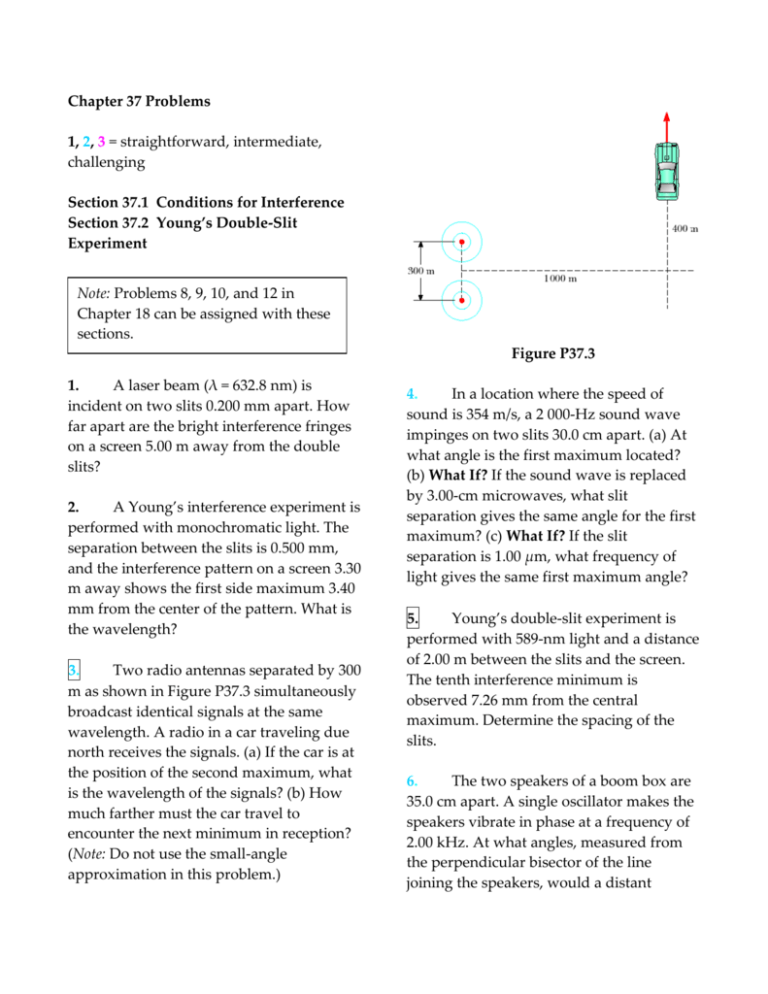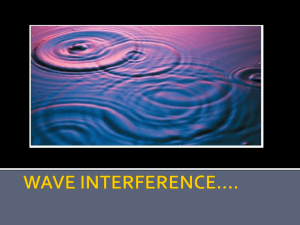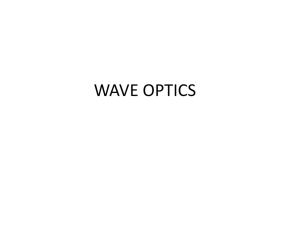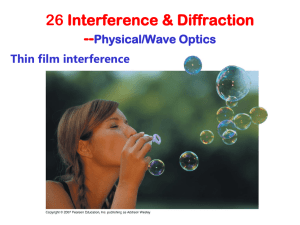
Chapter 37 Problems
1, 2, 3 = straightforward, intermediate,
challenging
Section 37.1 Conditions for Interference
Section 37.2 Young’s Double-Slit
Experiment
Note: Problems 8, 9, 10, and 12 in
Chapter 18 can be assigned with these
sections.
Figure P37.3
1.
A laser beam (λ = 632.8 nm) is
incident on two slits 0.200 mm apart. How
far apart are the bright interference fringes
on a screen 5.00 m away from the double
slits?
2.
A Young’s interference experiment is
performed with monochromatic light. The
separation between the slits is 0.500 mm,
and the interference pattern on a screen 3.30
m away shows the first side maximum 3.40
mm from the center of the pattern. What is
the wavelength?
3.
Two radio antennas separated by 300
m as shown in Figure P37.3 simultaneously
broadcast identical signals at the same
wavelength. A radio in a car traveling due
north receives the signals. (a) If the car is at
the position of the second maximum, what
is the wavelength of the signals? (b) How
much farther must the car travel to
encounter the next minimum in reception?
(Note: Do not use the small-angle
approximation in this problem.)
4.
In a location where the speed of
sound is 354 m/s, a 2 000-Hz sound wave
impinges on two slits 30.0 cm apart. (a) At
what angle is the first maximum located?
(b) What If? If the sound wave is replaced
by 3.00-cm microwaves, what slit
separation gives the same angle for the first
maximum? (c) What If? If the slit
separation is 1.00 μm, what frequency of
light gives the same first maximum angle?
5.
Young’s double-slit experiment is
performed with 589-nm light and a distance
of 2.00 m between the slits and the screen.
The tenth interference minimum is
observed 7.26 mm from the central
maximum. Determine the spacing of the
slits.
6.
The two speakers of a boom box are
35.0 cm apart. A single oscillator makes the
speakers vibrate in phase at a frequency of
2.00 kHz. At what angles, measured from
the perpendicular bisector of the line
joining the speakers, would a distant
observer hear maximum sound intensity?
Minimum sound intensity? (Take the speed
of sound as 340 m/s.)
7.
Two narrow, parallel slits separated
by 0.250 mm are illuminated by green light
(λ = 546.1 nm). The interference pattern is
observed on a screen 1.20 m away from the
plane of the slits. Calculate the distance (a)
from the central maximum to the first
bright region on either side of the central
maximum and (b) between the first and
second dark bands.
8.
Light with wavelength 442 nm
passes through a double-slit system that
has a slit separation d = 0.400 mm.
Determine how far away a screen must be
placed in order that a dark fringe appear
directly opposite both slits, with just one
bright fringe between them.
9.
A riverside warehouse has two open
doors as shown in Figure P37.9. Its walls
are lined with sound-absorbing material. A
boat on the river sounds its horn. To person
A the sound is loud and clear. To person B
the sound is barely audible. The principal
wavelength of the sound waves is 3.00 m.
Assuming person B is at the position of the
first minimum, determine the distance
between the doors, center to center.
Figure P37.9
10.
Two slits are separated by 0.320 mm.
A beam of 500-nm light strikes the slits,
producing an interference pattern.
Determine the number of maxima observed
in the angular range –30.0° < θ < 30.0°.
11.
Young’s double-slit experiment
underlies the Instrument Landing System
used to guide aircraft to safe landings when
the visibility is poor. Although real systems
are more complicated than the example
described here, they operate on the same
principles. A pilot is trying to align her
plane with a runway, as suggested in
Figure P37.11a. Two radio antennas A1 and
A2 are positioned adjacent to the runway,
separated by 40.0 m. The antennas
broadcast unmodulated coherent radio
waves at 30.0 MHz. (a) Find the wavelength
of the waves. The pilot “locks onto” the
strong signal radiated along an interference
maximum, and steers the plane to keep the
received signal strong. If she has found the
central maximum, the plane will have just
the right heading to land when it reaches
the runway. (b) What If? Suppose instead
that the plane is flying along the first side
maximum (Fig. P37.11b). How far to the
side of the runway centerline will the plane
be when it is 2.00 km from the antennas? (c)
It is possible to tell the pilot she is on the
wrong maximum by sending out two
signals from each antenna and equipping
the aircraft with a two-channel receiver.
The ratio of the two frequencies must not be
the ratio of small integers (such as 3/4).
Explain how this two-frequency system
would work, and why it would not
necessarily work if the frequencies were
related by an integer ratio.
screen is stationary. Find the speed of the
first-order maxima on the screen.
13.
In Figure 37.5 let L = 1.20 m and d =
0.120 mm and assume that the slit system is
illuminated with monochromatic 500-nm
light. Calculate the phase difference
between the two wave fronts arriving at P
when (a) θ = 0.500° and (b) y = 5.00 mm. (c)
What is the value of θ for which the phase
difference is 0.333 rad? (d) What is the
value of θ for which the path difference is
λ/4?
14.
Coherent light rays of wavelength λ
strike a pair of slits separated by distance d
at an angle θ1 as shown in Figure P37.14.
Assume an interference maximum is
formed at an angle θ2 a great distance from
the slits. Show that d(sin θ2 – sin θ1) = mλ,
where m is an integer.
Figure P37.11
12.
A student holds a laser that emits
light of wavelength 633 nm. The beam
passes though a pair of slits separated by
0.300 mm, in a glass plate attached to the
front of the laser. The beam then falls
perpendicularly on a screen, creating an
interference pattern on it. The student
begins to walk directly toward the screen at
3.00 m/s. The central maximum on the
Figure P37.14
15.
In a double-slit arrangement of
Figure 37.5, d = 0.150 mm, L = 140 cm, λ =
643 nm, and y = 1.80 cm. (a) What is the
path difference δ for the rays from the two
slits arriving at P? (b) Express this path
difference in terms of λ. (c) Does P
correspond to a maximum, a minimum, or
an intermediate condition?
Section 37.3 Intensity Distribution of the
Double-Slit Interference Pattern
16.
The intensity on the screen at a
certain point in a doubleslit interference
pattern is 64.0% of the maximum value. (a)
What minimum phase difference (in
radians) between sources produces this
result? (b) Express this phase difference as a
path difference for 486.1-nm light.
17.
In Figure 37.5, let L = 120 cm and d =
0.250 cm. The slits are illuminated with
coherent 600-nm light. Calculate the
distance y above the central maximum for
which the average intensity on the screen is
75.0% of the maximum.
18.
Two slits are separated by 0.180 mm.
An interference pattern is formed on a
screen 80.0 cm away by 656.3-nm light.
Calculate the fraction of the maximum
intensity 0.600 cm above the central
maximum.
19.
Two narrow parallel slits separated
by 0.850 mm are illuminated by 600-nm
light, and the viewing screen is 2.80 m
away from the slits. (a) What is the phase
difference between the two interfering
waves on a screen at a point 2.50 mm from
the central bright fringe? (b) What is the
ratio of the intensity at this point to the
intensity at the center of a bright fringe?
20.
Monochromatic coherent light of
amplitude E0 and angular frequency ω
passes through three parallel slits each
separated by a distance d from its neighbor.
(a) Show that the time-averaged intensity as
a function of the angle θ is
2d sin
I I max 1 2 cos
λ
2
(b) Determine the ratio of the intensities of
the primary and secondary maxima.
Section 37.4 Phasor Addition of Waves
Note: Problems 4, 5, and 6 in Chapter
18 can be assigned with this section.
21.
Marie Cornu, a physicist at the
Polytechnic Institute in Paris, invented
phasors in about 1880. This problem helps
you to see their utility. Find the amplitude
and phase constant of the sum of two
waves represented by the expressions
E1 = (12.0 kN/C) sin(15x – 4.5t)
E2 = (12.0 kN/C) sin(15x – 4.5t + 70°)
(a) by using a trigonometric identity (as
from Appendix B), and (b) by representing
the waves by phasors. (c) Find the
amplitude and phase constant of the sum of
the three waves represented by
E1 = (12.0 kN/C) sin(15x – 4.5t + 70°)
E2 = (15.5 kN/C) sin(15x – 4.5t – 80°)
E3 = (17.0 kN/C) sin(15x – 4.5t + 160°)
22.
The electric fields from three
coherent sources are described by E1 = E0
sin ωt, E2 = E0 sin(ωt + φ), and E3 = E0 sin(ωt
+ 2φ). Let the resultant field be represented
by EP = ER sin(ωt + α). Use phasors to find
ER and α when (a) φ = 20.0°, (b) φ = 60.0°,
and (c) φ = 120°. (d) Repeat when φ = (3π/2)
rad.
23.
Determine the resultant of the two
waves given by E1 = 6.0 sin(100 πt) and E2 =
8.0 sin(100 πt + π/2).
24.
Suppose the slit openings in a
Young’s double-slit experiment have
different sizes so that the electric fields and
intensities from each slit are different. With
E1 = E01 sin(ωt) and E2 = E02 sin(ωt = φ), show
that the resultant electric field is E = E0
sin(ωt + θ), where
2
2
E0 E01
E02
2E01 E02 cos
and
sin
E02 sin
E0
25.
Use phasors to find the resultant
(magnitude and phase angle) of two fields
represented by E1 = 12 sin ωt and E2 = 18
sin(ωt + 60°). (Note that in this case the
amplitudes of the two fields are unequal.)
26.
by
Two coherent waves are described
2x1
E1 E0 sin
2ft
6
λ
2x 2
E 2 E0 sin
2ft
8
λ
Determine the relationship between x1 and
x2 that produces constructive interference
when the two waves are superposed.
27.
When illuminated, four equally
spaced parallel slits act as multiple coherent
sources, each differing in phase from the
adjacent one by an angle φ. Use a phasor
diagram to determine the smallest value of
φ for which the resultant of the four waves
(assumed to be of equal amplitude) is zero.
28.
Sketch a phasor diagram to illustrate
the resultant of E1 = E01 sin ωt and E2 = E02
sin(ωt + φ), where E02 = 1.50E01 and π/6 ≤ φ ≤
π/3. Use the sketch and the law of cosines
to show that, for two coherent waves, the
resultant intensity can be written in the
form I R I 1 I 2 2 I 1 I 2 cos .
29.
Consider N coherent sources
described as follows: E1 = E0sin(ωt + φ), E2 =
E0sin(ωt + 2φ), E3 = E0sin(ωt + 3φ), . . . , EN =
E0 sin(ωt + Nφ). Find the minimum value of
φ for which ER = E1 + E2 + E3 + . . . + EN is
zero.
Section 37.5 Change of Phase Due to
Reflection
Section 37.6 Interference in Thin Films
30.
A soap bubble (n = 1.33) is floating in
air. If the thickness of the bubble wall is 115
nm, what is the wavelength of the light that
is most strongly reflected?
31.
An oil film (n = 1.45) floating on
water is illuminated by white light at
normal incidence. The film is 280 nm thick.
Find (a) the color of the light in the visible
spectrum most strongly reflected and (b)
the color of the light in the spectrum most
strongly transmitted. Explain your
reasoning.
32.
A thin film of oil (n = 1.25) is located
on a smooth wet pavement. When viewed
perpendicular to the pavement, the film
reflects most strongly red light at 640 nm
and reflects no blue light at 512 nm. How
thick is the oil film?
33.
A possible means for making an
airplane invisible to radar is to coat the
plane with an antireflective polymer. If
radar waves have a wavelength of 3.00 cm
and the index of refraction of the polymer is
n = 1.50, how thick would you make the
coating?
passes the red hydrogen spectral line of
wavelength 656.3 nm, called the Hα line.
The filter consists of a transparent dielectric
of thickness d held between two partially
aluminized glass plates. The filter is held at
a constant temperature. (a) Find the
minimum value of d that produces
maximum transmission of perpendicular
Hα light, if the dielectric has an index of
refraction of 1.378. (b) What If? If the
temperature of the filter increases above the
normal value, what happens to the
transmitted wavelength? (Its index of
refraction does not change significantly.) (c)
The dielectric will also pass what nearvisible wavelength? One of the glass plates
is colored red to absorb this light.
37.
A beam of 580-nm light passes
through two closely spaced glass plates, as
shown in Figure P37.37. For what minimum
nonzero value of the plate separation d is
the transmitted light bright?
34.
A material having an index of
refraction of 1.30 is used as an antireflective
coating on a piece of glass (n = 1.50). What
should be the minimum thickness of this
film in order to minimize reflection of 500nm light?
35.
A film of MgF2 (n = 1.38) having
thickness 1.00 × 10–5 cm is used to coat a
camera lens. Are any wavelengths in the
visible spectrum intensified in the reflected
light?
36.
Astronomers observe the
chromosphere of the Sun with a filter that
Figure P37.37
38.
When a liquid is introduced into the
air space between the lens and the plate in a
Newton’s-rings apparatus, the diameter of
the tenth ring changes from 1.50 to 1.31 cm.
Find the index of refraction of the liquid.
39.
An air wedge is formed between two
glass plates separated at one edge by a very
fine wire, as shown in Figure P37.39. When
the wedge is illuminated from above by
600-nm light and viewed from above, 30
dark fringes are observed. Calculate the
radius of the wire.
42.
Monochromatic light is beamed into
a Michelson interferometer. The movable
mirror is displaced 0.382 mm, causing the
interferometer pattern to reproduce itself 1
700 times. Determine the wavelength of the
light. What color is it?
43.
One leg of a Michelson
interferometer contains an evacuated
cylinder of length L, having glass plates on
each end. A gas is slowly leaked into the
cylinder until a pressure of 1 atm is
reached. If N bright fringes pass on the
screen when light of wavelength λ is used,
what is the index of refraction of the gas?
Additional Problems
Figure P37.39
40.
Two glass plates 10.0 cm long are in
contact at one end and separated at the
other end by a thread 0.050 0 mm in
diameter (Fig. P37.39). Light containing the
two wavelengths 400 nm and 600 nm is
incident perpendicularly and viewed by
reflection. At what distance from the
contact point is the next dark fringe?
Section 37.7 The Michelson
Interferometer
41.
Mirror M1 in Figure 37.22 is
displaced a distance ΔL. During this
displacement, 250 fringe reversals
(formation of successive dark or bright
bands) are counted. The light being used
has a wavelength of 632.8 nm. Calculate the
displacement ΔL.
44.
In the What If? section of Example
37.2, it was claimed that overlapping
fringes in a two-slit interference pattern for
two different wavelengths obey the
following relationship even for large values
of the angle θ:
λ m'
λ' m
(a) Prove this assertion. (b) Using the data
in Example 37.2, find the value of y on the
screen at which the fringes from the two
wavelengths first coincide.
45.
One radio transmitter A operating at
60.0 MHz is 10.0 m from another similar
transmitter B that is 180° out of phase with
A. How far must an observer move from A
toward B along the line connecting A and B
to reach the nearest point where the two
beams are in phase?
46.
Review problem. This problem
extends the result of Problem 12 in Chapter
18. Figure P37.46 shows two adjacent
vibrating balls dipping into a tank of water.
At distant points they produce an
interference pattern of water waves, as
shown in Figure 37.3. Let λ represent the
wavelength of the ripples. Show that the
two sources produce a standing wave along
the line segment, of length d, between them.
In terms of λ and d, find the number of
nodes and the number of antinodes in the
standing wave. Find the number of zones of
constructive and of destructive interference
in the interference pattern far away from
the sources. Each line of destructive
interference springs from a node in the
standing wave and each line of constructive
interference springs from an antinode.
Courtesy of Central Scientific Company
Figure P37.46
47.
Raise your hand and hold it flat.
Think of the space between your index
finger and your middle finger as one slit,
and think of the space between middle
finger and ring finger as a second slit. (a)
Consider the interference resulting from
sending coherent visible light
perpendicularly through this pair of
openings. Compute an order-of-magnitude
estimate for the angle between adjacent
zones of constructive interference. (b) To
make the angles in the interference pattern
easy to measure with a plastic protractor,
you should use an electromagnetic wave
with frequency of what order of
magnitude? How is this wave classified on
the electromagnetic spectrum?
48.
In a Young’s double-slit experiment
using light of wavelength λ, a thin piece of
Plexiglas having index of refraction n
covers one of the slits. If the center point on
the screen is a dark spot instead of a bright
spot, what is the minimum thickness of the
Plexiglas?
49.
Review problem. A flat piece of
glass is held stationary and horizontal
above the flat top end of a 10.0-cm-long
vertical metal rod that has its lower end
rigidly fixed. The thin film of air between
the rod and glass is observed to be bright
by reflected light when it is illuminated by
light of wavelength 500 nm. As the
temperature is slowly increased by 25.0°C,
the film changes from bright to dark and
back to bright 200 times. What is the
coefficient of linear expansion of the metal?
50.
A certain crude oil has an index of
refraction of 1.25. A ship dumps 1.00 m3 of
this oil into the ocean, and the oil spreads
into a thin uniform slick. If the film
produces a first-order maximum of light of
wavelength 500 nm normally incident on it,
how much surface area of the ocean does
the oil slick cover? Assume that the index of
refraction of the ocean water is 1.34.
51.
Astronomers observed a 60.0-MHz
radio source both directly and by reflection
from the sea. If the receiving dish is 20.0 m
above sea level, what is the angle of the
radio source above the horizon at first
maximum?
52.
Interference effects are produced at
point P on a screen as a result of direct rays
from a 500-nm source and reflected rays
from the mirror, as shown in Figure P37.52.
Assume the source is 100 m to the left of the
screen and 1.00 cm above the mirror. Find
the distance y to the first dark band above
the mirror.
Figure P37.52
53.
The waves from a radio station can
reach a home receiver by two paths. One is
a straight-line path from transmitter to
home, a distance of 30.0 km. The second
path is by reflection from the ionosphere (a
layer of ionized air molecules high in the
atmosphere). Assume this reflection takes
place at a point midway between receiver
and transmitter and that the wavelength
broadcast by the radio station is 350 m.
Find the minimum height of the
ionospheric layer that produces destructive
interference between the direct and
reflected beams. (Assume that no phase
change occurs on reflection.)
54.
Many cells are transparent and
colorless. Structures of great interest in
biology and medicine can be practically
invisible to ordinary microscopy. An
interference microscope reveals a difference in
refractive index as a shift in interference
fringes, to indicate the size and shape of cell
structures. The idea is exemplified in the
following problem: An air wedge is formed
between two glass plates in contact along
one edge and slightly separated at the
opposite edge. When the plates are
illuminated with monochromatic light from
above, the reflected light has 85 dark
fringes. Calculate the number of dark
fringes that appear if water (n = 1.33)
replaces the air between the plates.
55.
Measurements are made of the
intensity distribution in a Young’s
interference pattern (see Fig. 37.7). At a
particular value of y, it is found that I/Imax =
0.810 when 600-nm light is used. What
wavelength of light should be used to
reduce the relative intensity at the same
location to 64.0% of the maximum
intensity?
56.
Our discussion of the techniques for
determining constructive and destructive
interference by reflection from a thin film in
air has been confined to rays striking the
film at nearly normal incidence. What If?
Assume that a ray is incident at an angle of
30.0° (relative to the normal) on a film with
index of refraction 1.38. Calculate the
minimum thickness for constructive
interference of sodium light with a
wavelength of 590 nm.
57.
The condition for constructive
interference by reflection from a thin film in
air as developed in Section 37.6 assumes
nearly normal incidence. What If? Show
that if the light is incident on the film at a
nonzero angle φ1 (relative to the normal),
then the condition for constructive
interference is 2nt cos θ2 = (m + ½)λ, where
θ2 is the angle of refraction.
58.
(a) Both sides of a uniform film that
has index of refraction n and thickness d are
in contact with air. For normal incidence of
light, an intensity minimum is observed in
the reflected light at λ2 and an intensity
maximum is observed at λ1, where λ1 > λ2.
Assuming that no intensity minima are
observed between λ1 and λ2, show that the
integer m in Equations 37.16 and 37.17 is
given by m = λ1/2(λ1 – λ2). (b) Determine the
thickness of the film, assuming n = 1.40, λ1 =
500 nm, and λ2 = 370 nm.
59.
Figure P37.59 shows a radio-wave
transmitter and a receiver separated by a
distance d and both a distance h above the
ground. The receiver can receive signals
both directly from the transmitter and
indirectly from signals that reflect from the
ground. Assume that the ground is level
between the transmitter and receiver and
that a 180° phase shift occurs upon
reflection. Determine the longest
wavelengths that interfere (a)
constructively and (b) destructively.
Figure P37.59
60.
A piece of transparent material
having an index of refraction n is cut into
the shape of a wedge as shown in Figure
P37.60. The angle of the wedge is small.
Monochromatic light of wavelength λ is
normally incident from above, and viewed
from above. Let h represent the height of
the wedge and ℓ its width. Show that bright
fringes occur at the positions x = λℓ(m +
½)/2hn and dark fringes occur at the
positions x = λℓm/2hn, where m = 0, 1, 2, . . .
and x is measured as shown.
illuminated from above by light of
wavelength λ. Show that the dark
Newton’s rings have radii given
approximately by
r
Figure P37.60
61.
Consider the double-slit
arrangement shown in Figure P37.61,
where the slit separation is d and the slit to
screen distance is L. A sheet of transparent
plastic having an index of refraction n and
thickness t is placed over the upper slit. As
a result, the central maximum of the
interference pattern moves upward a
distance y’. Find y’.
Figure P37.61
62.
A plano-convex lens has index of
refraction n. The curved side of the lens has
radius of curvature R and rests on a flat
glass surface of the same index of
refraction, with a film of index nfilm between
them, as shown in Fig. 37.18a. The lens is
mλR
nfilm
where m is an integer and r is much less
than R.
63.
In a Newton’s-rings experiment, a
plano-convex glass (n = 1.52) lens having
diameter 10.0 cm is placed on a flat plate as
shown in Figure 37.18a. When 650-nm light
is incident normally, 55 bright rings are
observed with the last one right on the edge
of the lens. (a) What is the radius of
curvature of the convex surface of the lens?
(b) What is the focal length of the lens?
64.
A plano-concave lens having
refractive index 1.50 is placed on a flat glass
plate, as shown in Figure P37.64. Its curved
surface, with radius of curvature 8.00 m, is
on the bottom. The lens is illuminated from
above with yellow sodium light of
wavelength 589 nm, and a series of
concentric bright and dark rings is
observed by reflection. The interference
pattern has a dark spot at the center,
surrounded by 50 dark rings, of which the
largest is at the outer edge of the lens. (a)
What is the thickness of the air layer at the
center of the interference pattern? (b)
Calculate the radius of the outermost dark
ring. (c) Find the focal length of the lens.
Figure P37.64
65.
A plano-convex lens having a radius
of curvature of r = 4.00 m is placed on a
concave glass surface whose radius of
curvature is R = 12.0 m, as shown in Figure
P37.65. Determine the radius of the 100th
bright ring, assuming 500-nm light is
incident normal to the flat surface of the
lens.
Figure P37.65
66.
Use phasor addition to find the
resultant amplitude and phase constant
when the following three harmonic
functions are combined: E1 = sin(ωt + π/6),
E2 = 3.0 sin(ωt + 7π/2), and E3 = 6.0 sin(ωt +
4π/3).
67.
A soap film (n = 1.33) is contained
within a rectangular wire frame. The frame
is held vertically so that the film drains
downward and forms a wedge with flat
faces. The thickness of the film at the top is
essentially zero. The film is viewed in
reflected white light with near-normal
incidence, and the first violet (λ = 420 nm)
interference band is observed 3.00 cm from
the top edge of the film. (a) Locate the first
red (λ = 680 nm) interference band. (b)
Determine the film thickness at the
positions of the violet and red bands. (c)
What is the wedge angle of the film?
68.
Compact disc (CD) and digital video
disc (DVD) players use interference to
generate a strong signal from a tiny bump.
The depth of a pit is chosen to be one
quarter of the wavelength of the laser light
used to read the disc. Then light reflected
from the pit and light reflected from the
adjoining flat differ in path length traveled
by one-half wavelength, to interfere
destructively at the detector. As the disc
rotates, the light intensity drops
significantly every time light is reflected
from near a pit edge. The space between the
leading and trailing edges of a pit
determines the time between the
fluctuations. The series of time intervals is
decoded into a series of zeros and ones that
carries the stored information. Assume that
infrared light with a wavelength of 780 nm
in vacuum is used in a CD player. The disc
is coated with plastic having a refractive
index of 1.50. What should be the depth of
each pit? A DVD player uses light of a
shorter wavelength, and the pit dimensions
are correspondingly smaller. This is one
factor resulting in greater storage capacity
on a DVD compared to a CD.
three times larger. Find the minimum
possible value for the slit separation d.
69.
Interference fringes are produced
using Lloyd’s mirror and a 606-nm source
as shown in Figure 37.15. Fringes 1.20 mm
apart are formed on a screen 2.00 m from
the real source S. Find the vertical distance
h of the source above the reflecting surface.
70.
Monochromatic light of wavelength
620 nm passes through a very narrow slit S
and then strikes a screen in which are two
parallel slits, S1 and S2, as in Figure P37.70.
Slit S1 is directly in line with S and at a
distance of L = 1.20 m away from S, whereas
S2 is displaced a distance d to one side. The
light is detected at point P on a second
screen, equidistant from S1 and S2. When
either one of the slits S1 and S2 is open,
equal light intensities are measured at point
P. When both are open, the intensity is
© Copyright 2004 Thomson. All rights reserved.
Figure P37.70
71.
Slit 1 of a double slit is wider than
slit 2, so that the light from 1 has an
amplitude 3.00 times that of the light from
2. Show that for this situation, Equation
37.11 is replaced by the equation I =
(4Imax/9)(1 + 3 cos2 φ/2).









